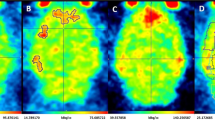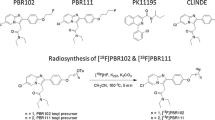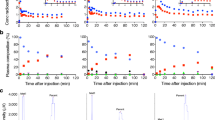Summary
Chronological studies of the development of the peripheral benzodiazepine receptor sites were undertaken with the goal of evaluating the sensitivity of this marker for the study of the gliosis development in the injured brain. No significant increase in [3H] PK-11195 binding occurred in the rat brain stab wound one day following the puncture. A significant increase in the receptor density (Bmax) from the second day onward was observed. The Bmax reached its highest levels in the grey matter on the sixth day after a 23-gauge needle wound (8.75 ± 0.09; pmol mg-tissue−1) and on the seventh day after an 18-gauge needle wound (8.98 ± 0.31 pmol mgtissue−1). In the white matter, the Bmaxwas greatest seven days after the wound (3.42 ± 0.07; pmol mg-tissue−1; 23-gauge needle and 3.56 ±0.1 pmol mg-tissue−1 in the 18-gauge needle injury). Between 30 and 60 days after the wound, the Bmax was significantly lower than the Bmax observed between 6 and 14 days. The Bmax in the wound produced with needles was seven to eight times greater than the Bmax in the grey matter of the ipsilateral and contralateral cortices. Histological examination showed that there were no astrocytes or macrophages in the stab wound one day after the lesion. However, the glial fibrillary acidic protein positive cells and macrophages appeared on D3 after an injury. Gliosis, as measured by the PK-11195 binding, was also observed in the remote contralateral cortex. Data shows that PK-11195 binding is a very sensitive method of evaluating brain injury and could be of great value in studying progressive injuries in the living human brain in conjunction with positron emission tomography.
Similar content being viewed by others
References
Altar CA, Baudry M (1990) Systemic injection of kainic acid: gliosis in olfactory and limbic brain regions quantified with [3H] PK-11195 binding autoradiography. Exp Neurol 109: 333–341
Anholt RR, De Souza EB, Oster-Granite ML, Snyder SH (1985) Peripheral-type benzodiazepine receptors: autoradiographic localization in whole-body sections of neonatal rats. J Pharm Exp Therap 233: 517–520
Anholt RRH (1986) Mitochondrial benzodiazepine receptors as potential modulators of intermediary metabolism. Trends Pharmacol Sci 7: 506
Awad M, Gavish M (1987) Binding of [3H] R05-4864 and [3H] PK-11195 to cerebral cortex and peripheral tissues of various species: species differences and heterogeneity in peripheral benzodiazepine binding sites. J Neurochem 49: 1407–1414
Basile AS, Skolnick P (1986) Subcellular localization of “peripheral type” binding sites for benzodiazepine in rat brain. J Neurochem 46: 305–308
Benavides J, Fage D, Carter D, Scatton B (1987) Peripheral type benzodiazepine binding sites are sensitive in direct index of neuronal damage. Brain Res 421: 167–172
Benavides J, Cornu P, Dennis T, Dubois A, Hauw JJ, MacKenzie ET, Sazdovitch V, Scatton B (1988) Imaging of human brain lesions with an ω3 site radioligand. Ann Neurol 24: 708–712
Benavides J, Quarteronet D, Polouin PF, Imbault F, Phan T, Uzan A, Renault C, Dubroeucq MC, Gueremy C, Le Fur G (1984) Characterization of peripheral type benzodiazepine binding sites in human and rat platelets by using [3H] PK- 11195. Studies in hypertensive patients. Biochem Pharmacol 33: 2467–2472
Benavides J, Dubois A, Dennis T, Hamel E, Scatton B (1989) ω3 (peripheral type benzodiazepine binding) site distribution in rat immune system: an autoradiographic study with the photoaffinity ligand [3H] PK-11195. J Pharmacol Exp Ther 249: 333–339
Black KL, Ikezaki K, Toga AW (1989) Imaging of brain tumors using peripheral benzodiazepine receptor ligands. J Neurosurg 71: 113–118
Braestrup B, Nielsen M (1983) Benzodiazepine receptors. In: Iversen LL, Iversen SD, Snyder SH (eds) Handbook of psychopharmacology, vol 17. Plenum, New York, 285–384
Camson R, Crouzel C, Comar D, Maziere M, Prenant C, Sastre J, Moulin MA, Syrota A (1984) Synthesis of N(11C)methyl, N-(methyl-1 propyl), (chloro-2 phenyl)-1 isoquinoleine carboxamide-3 (PK-11195): a new ligand for peripheral benzodiazepine receptors. J Label Comp Radiopharm 21: 985–991
Doble A, Malgouris C, Daniel M, Daniel N, Imbault F, Basbaum A, Uzan A, Gueremy C, Le Fur G (1987) Labelling of peripheral-type benzodiazepine binding sites in human brain with [3H] PK-11195: anatomical and subcellular distribution. Brain Res Bull 18: 49–61
Doble A, Benavides J, Ferris O, Bertrand P, Menager J, Vaucher N, Burgevin MC, Uzan A, Gueremy C, La Fur G (1985) Dihydropyridine and peripheral-type benzodiazepine binding sites: subcellular distribution and molecular size determination. Eur J Pharmacol 119: 153–167
Dubois A, Benavides J, Peny B, Duverger D, Fage D, Gotti B, MacKenzie ET, Scatton B (1988) Imaging of primary and remote ischemic and excitotoxic brain lesions. An autoradiographic study of peripheral type benzodiazepine binding sites in the rat and cat. Brain Res 445: 77–90
Ferrarese C, Appollonio I, Frigo M, Perego M, Pierpaoli C, Trabucchi M, Frattola L (1990) Characterization of peripheral benzodiazepine receptors in human blood mononuclear cells. Neuropharmacology 29: 375–378
Ferrarese C, Appollonio I, Frigo M, Gaini SM, Piolti R, Frattola L (1989) Benzodiazepine receptors and diazepine binding inhibitor in human cerebral tumors. Ann Neurol 26: 564–568
Gildersleeve DL, Lin TY, Wieland DM, Ciliax BJ, Olson JM, Young AB (1989) Synthesis of a high activity [125I]-labelled analog of PK-11195, potential agent for SPECT imaging of the peripheral benzodiazepine binding site. Nucl Med Biol 16: 423–429
Giulian D, Chen J, Ingeman FE, George JK, Noponen M (1989) The role of mononuclear phagocytes in wound healing after traumatic injury to adult mammalian brain. J Neurosci 9: 4416–4429
Giulian D, Woodward J, Young DG, Krebs JE, Lachman LB (1988) Interleukin-1 injected into mammalian brain stimulates astrogliosis and neovascularization. J Neurosci 8: 2485–2490
Giulian D, Lachman LB (1985) Interleukin-1 stimulation of astroglial proliferation after brain injury. Science 228: 497–499
Hozumi I, Chiu FC, Norton WT (1990) Biochemical and immunocytochemical changes in glial fibrillary acidic protein after stab wounds. Brain Res 524: 64–71
Ikezaki K, Black KL, Toga AW, Santori EM, Becker DP, Smith ML (1990) Imaging peripheral benzodiazepine receptors in brain tumors in rats: in vitro binding characteristic. J Cereb Blood Flow Metab 10: 580–587
Junck L, Jewett DM, Kilbourn MR, Greenberg HS, Young AB, Kuhl DE (1991) Brain tumor imaging with [11C] PK-11195, a ligand for the peripheral benzodiazepine binding site. J Cereb Blood Flow Metab 11: S594
Levtz A, Schachner M (1981) Epidermal growth factor stimulates DNA-synthesis of astrocytes in primary cerebellar cultures. Exp Tissue Res 120: 393–404
Matthew E, Laskin JD, Zimmerman EA, Weinstein IB, Hsu KC, Engelhardt DL (1981) Benzodiazepines have high affinity binding sites and induce melanogenesis in B16/C3 melanoma cells. Proc Natl Acad Sci USA 78: 3935–3939
McCarthy KD, Harden TK (1981) Identification of two benzodiazepine binding sites on cells cultured from rat cerebral cortex. J Pharmacol Exp Ther 216: 183–191
McGeer EG, Singh EA, McGeer PL (1988) Peripheral-type benzodiazepine binding in Alzheimer's disease. Alzheimer Dis Assoc Disord 2: 331–336
Miller RH, Abney ER, David S, French-Constant C, Lindsay R, Patel R, Stone J, Raff MC (1986) Is reactive gliosis a property of a distinct subpopulation of astrocytes? J Neurosci 6: 22–99
Miyake T, Hattori T, Fukuda M, Kitamura T, Fujita S (1988) Quantitative studies on proliferative changes of reactive astrocytes in mouse cerebral cortex. Brain Res 451: 133–138
Morshead CM, Van Der Kooy D (1990) Separate blood and brain origins of proliferating cells during gliosis in adult brains. Brain Res 535: 237–244
Moumdjian RA, Antel JP, Yong VW (1991) Origin of contralateral reactive gliosis in surgically injured rat cerebral cortex. Brain Res 547: 223–228
Myers R, Manjil LG, Cullen BM, Price GW, Frackowiak RSJ, Cremer JE (1991) Macrophage and astrocyte populations in relation to [3H] PK-11195 binding in rat cerebral cortex following a local ischemic lesion. J Cereb Blood Flow Metab 11: 314–322
Olson JMM, Ciliax BJ, Mancini WR, Young AB (1988) Presence of peripheral-type benzodiazepine binding sites on human erythrocyte membranes. Eur J Pharmacol 152: 47–53
Owen F, Poulter M, Waddington JL, Marshal RD, Crow TJ (1983) [3H] R05-4864 and [3H] Flunitrazepam binding sites in kainite-lesioned rat striatum and in temporal cortex of brains from patients with senile dementia of Alzheimer subtype. Brain Res 278: 373–375
Roessmann V, Gambetti P (1986) Pathological reaction of astrocytes in perinatal injury. Acta Neuropathol 70: 302–307
Schiffer D, Giordana MT, Migheli A, Giaccone G, Pezzottaa S, Mauro A (1986) Glial fibrillary acidic protein and vimentin in the experimental glial reaction of the rat brain. Brain Res 374: 110–118
Scoemaker H, Morelli M, Deshmukh P, Yamamura HI (1982) [3H] R05-4864 benzodiazepine binding in the kainite lesioned striatum and Huntington's diseased basal ganglia. Brain Res 248: 396–401
Selmaj KN, Farrop M, Norton WT, Raine CS, Brosnan CF (1990) Proliferation of astrocytes in vitro in response to cytokines. J Immunol 144: 129–135
Shiraishi T, Black KL, Ikekazi K, Becker DP (1991) Peripheral benzodiazepine induces morphological changes and proliferation of mitochondria in glioma cells. J Neurosci Res 30: 463–474
Starosta-Rubinstein S, Ciliax B, Penny JB, McKeever P, Young AB (1987) Imaging of a glioma using peripheral benzodiazepine receptor ligands. Proc Natl Acad Sci USA 84: 891–895
Sypine PJ, Skolnick P (1979) Characterization of benzodiazepine binding sites in cultured cells of neuronal origin. J Neurochem 32: 1047–1051
Takada A, Mitsuka S, Diksic M, Yamamoto YL (1992) Autoradiographic study of peripheral benzodiazepine receptors in animal brain tumor models and human gliomas. Eur J Pharmacol Environ Toxicol Pharmacol 228: 131–139
Takamiya Y, Kohsaka S, Toya S, Otani M, Mikoshiba K, Tsukada Y (1986) Possible association of platelet-derived growth factor (PDGF) with the appearance of reactive astrocytes following brain injury in situ. Brain Res 383: 305–309
Taniguchi T, Wang JKT, Spector S (1980) Properties of [3H] diazepam binding to rat peritoneal mast cells. Life Sci 27: 171–178
Topp KS, Faddis BT, Vijayan VK (1989) Trauma-induced proliferation of astrocytes in the brain of young and aged rats. Glia 2: 201–211
Weissman BA, Bolger GT, Isaac L, Paul SM, Skolnick P (1984) Characterization of the binding of [3H] R05-4864, a convulsant benzodiazepine, to guinea pig brain. J Neurochem 42: 969–975
Yong VW, Kim SV, Pleasure DE (1988) Growth factors for fetal and adult human astrocytes in culture. Brain Res 444: 59–66
Zavala F, Haumont J, Lenfant M (1984) Interaction of benzodiazepines with mouse macrophages. Eur J Pharmacol 106: 561–566
Author information
Authors and Affiliations
Additional information
Was on leave of absence from Yamanashi Medical College, Department of Neurosurgery, Yamanashi, Japan.
Rights and permissions
About this article
Cite this article
Miyazawa, N., Diksic, M. & Yamamoto, Y. Chronological study of peripheral benzodiazepine binding sites in the rat brain stab wounds using [3H] PK-11195 as a marker for gliosis. Acta neurochir 137, 207–216 (1995). https://doi.org/10.1007/BF02187195
Issue Date:
DOI: https://doi.org/10.1007/BF02187195




